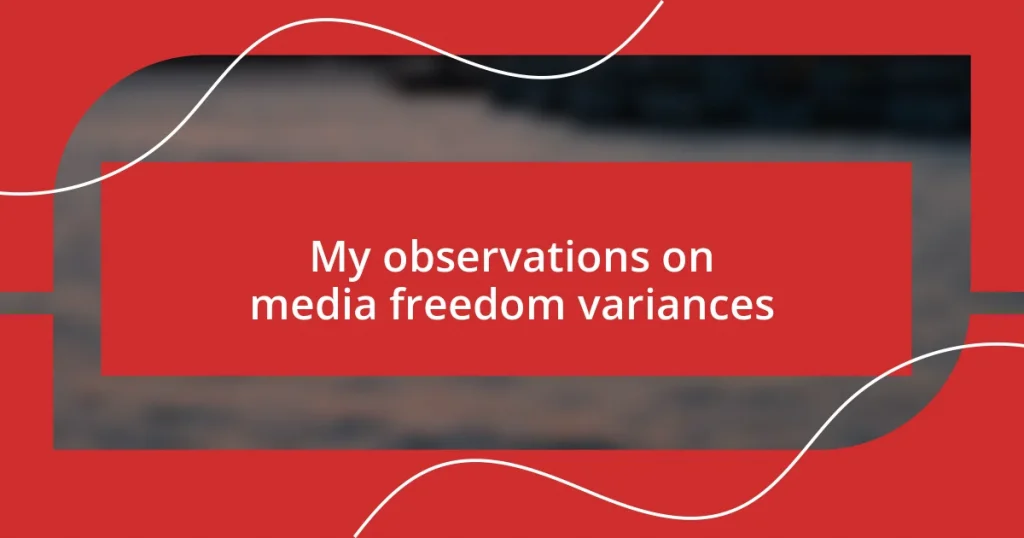Key takeaways:
- Global news coverage is shaped by cultural perspectives and technological evolution, impacting how stories are perceived and consumed.
- Key strategies in effective news reporting include incorporating diverse voices, visual storytelling, and contextualization to enhance audience engagement.
- Future trends in news reporting may involve AI, immersive technologies, and collaborative journalism, aiming to foster deeper understanding and accountability.

Understanding global news coverage
Understanding global news coverage can be quite a complex endeavor. It’s fascinating how different cultures interpret the same event in distinct ways, isn’t it? I remember watching news from diverse global sources during a significant crisis, and the variance in focus and tone really caught my attention.
One time, I noticed that while one outlet highlighted humanitarian impacts, another prioritized political implications. This experience made me realize that news is often filtered through cultural lenses, shaping our perceptions. How often do we take a moment to reflect on those lenses? It can be eye-opening to think about what might be left out in the stories we consume daily.
Moreover, the evolution of technology continues to redefine what global news coverage looks like. Mobile devices and social media have not only accelerated the dissemination of news but also democratized who gets to share it. I often find myself asking, how does this shift affect the credibility of what we read? Understanding these nuances is crucial for anyone who wants to stay informed in today’s fast-paced world.

Key strategies in news reporting
Effective news reporting relies on several key strategies that enhance audience engagement and ensure clarity. One of the most impactful strategies I’ve seen is the use of local perspectives. When reporters connect global events to local experiences, it creates a relatable narrative for readers. I remember watching a segment on climate change that focused on how rising sea levels were affecting a small coastal town. The personal stories added depth and urgency to the report, making the issue feel immediate and real.
Here are some key strategies in news reporting:
- Incorporating Diverse Voices: Engaging a variety of sources amplifies different perspectives, providing a more comprehensive view of the story.
- Visual Storytelling: Using graphics or videos can help convey complex information quickly and effectively, making the content more accessible.
- Contextualization: Placing news within a broader historical or cultural context helps readers understand its significance and implications.
- Clear and Concise Language: Writing in a straightforward manner allows your audience to grasp the essential points without unnecessary jargon.
- Follow-up Reporting: Continuing coverage of an issue ensures that stories develop further and keeps the audience informed about ongoing developments.
These strategies reflect my belief that news reporting should not only inform but also resonate with the audience on a personal level. It’s all about creating a connection.

Challenges in global news coverage
Challenges in global news coverage are numerous and complex. One significant hurdle is the sheer volume of information available. I often find myself overwhelmed by the rapid flow of news from around the world, making it tough to discern credible sources. This flood can distort our understanding, causing vital stories to get overshadowed by sensationalism or trivial updates. How do we navigate this sea of data while honing in on what truly matters?
Another challenge is the geopolitical context in which news is reported. For example, when covering a conflict, different countries may frame events in ways that reflect their political agendas. I’ve felt the stark contrast between how a particular event was portrayed in my own country compared to international outlets. It’s a sobering reminder that biases exist, and we must actively seek diverse perspectives to form a well-rounded opinion.
Finally, accessibility poses a significant barrier. Not everyone has equal access to technology or language skills needed to engage with global news. I remember meeting someone who felt disconnected from world events because they couldn’t access reliable translations. This inequity reinforces the idea that global news coverage isn’t just about sharing information—it’s about inclusivity and ensuring everyone can participate in the conversation.
| Challenge | Description |
|---|---|
| Information Overload | Rapid news flow can obscure important stories. |
| Geopolitical Bias | Different countries frame events based on political interests. |
| Accessibility | Lack of access to tech and language skills limits engagement. |

Cultural considerations in news
When I think about the cultural considerations in news coverage, one aspect that stands out is the importance of understanding local customs and values. In my experience, reporting a story without this contextual knowledge can lead to misunderstandings or even offense. For instance, I recall a piece on a festival that featured traditional practices. The journalist omitted crucial cultural nuances, and it inadvertently misrepresented the event. This misstep made me wonder how many stories go untold or wrongly told due to a lack of cultural sensitivity.
Additionally, I’ve observed how language barriers can impact news reception. In covering a humanitarian crisis, certain memes and phrases don’t translate well, which can skew public perception. I remember discussing a global health issue with a friend from a different country who expressed confusion about terminology that was common in my own culture. It struck me that effective reporting should bridge these gaps rather than create them, fostering clearer understanding across cultural boundaries.
Interestingly, the representation of marginalized voices can significantly influence the overall narrative of a story. Reflecting on my time volunteering with local communities, I’ve seen firsthand how including diverse perspectives can transform a report. It’s like having a patchwork quilt; the more varied the pieces, the richer the story. This makes me think—are we doing enough to ensure all voices are heard in news coverage? I believe that when these diverse narratives are prioritized, the audience gains a deeper and more meaningful understanding of global events.

Digital transformation of news media
In today’s fast-paced digital landscape, the transformation of news media is nothing short of remarkable. I remember a time when I’d eagerly await the evening news, but now, information floods my screen as soon as it happens. This immediacy has shaped my consumption habits; I often find myself scrolling through breaking news on social media, which sparks the question—are we losing the depth of reporting for speed?
The rise of mobile devices has democratized news access, allowing anyone with a smartphone to share their perspective. Personally, I’ve often turned to citizen journalism during crises, which paints a raw picture that traditional media sometimes misses. However, I sometimes worry about the accuracy of this content. Can anyone with good intentions truly provide the full story without proper context? It’s a tricky balance that highlights the need for media literacy in navigating these diverse sources.
Moreover, the shift to digital platforms has led to changes in revenue models as advertising pivots towards online spaces. I see many outlets grappling with paywalls, which makes me ponder—how can smaller publications sustain their voices in such a competitive environment? It’s essential for us, as consumers, to support quality journalism so we don’t lose the valuable insights provided by seasoned reporters who are often buried under a mountain of free content.

Case studies of successful coverage
When it comes to successful global news coverage, I often think about the in-depth reporting done during significant events like the Arab Spring. I remember watching journalists who embedded themselves within communities, speaking the local language and sharing the voices of everyday people. This approach not only provided authenticity but also humanized the struggles of those involved, resonating deeply with global audiences. It made me realize how impactful storytelling can be when we truly listen to those directly affected.
Another compelling case I recall is the coverage of Australia’s bushfires. The media didn’t just report statistics; they shared personal stories of loss and resilience, weaving a tapestry of experiences that connected viewers emotionally. I found myself moved by the stories of affected families and their determination to rebuild. It raised the question—how often do we see beyond the numbers to connect with the human aspect of news? This kind of coverage not only informs but also fosters empathy, which is crucial in our globally interconnected world.
I also think about the role of social media during major events like the Black Lives Matter movement. It was fascinating to see how grassroots movements leveraged platforms to spread their message, turning local protests into global conversations. I felt a sense of urgency and unity with people across the world, all rallying behind a common cause. Do we fully appreciate the power that social media has in shaping narratives and creating change? This phenomenon illustrates that successful news coverage today doesn’t just rely on traditional outlets; it thrives on the engagement of ordinary people sharing their truths.

Future trends in news reporting
As I look ahead to the future of news reporting, I can’t shake the feeling that artificial intelligence will play a pivotal role. Personally, I’ve experienced how AI algorithms curate news feeds, often bringing me stories that align with my interests. But isn’t there a risk that this could create echo chambers, limiting exposure to diverse perspectives? I believe it’s essential for us to challenge these algorithms, seeking out stories that broaden our understanding rather than just reinforce our viewpoints.
The integration of immersive technologies, like augmented reality (AR) and virtual reality (VR), has been on my mind lately as well. Imagine being able to step into a story, walking through a virtual environment that reflects the realities faced by those impacted by events unfolding around the world. This kind of engagement could foster deeper empathy and understanding. Still, I wonder: will we embrace these innovations responsibly, or could they lead to sensationalism?
Additionally, with the growing emphasis on transparency and accountability, I feel there’s a shift toward more collaborative journalism. I’ve observed how news organizations are working alongside communities to create content that reflects the collective narrative, rather than imposing an external viewpoint. This makes me hopeful—can we truly change the landscape of journalism if we keep centering those directly affected by the stories we tell? It’s a promising trend, and it might just redefine trust in media if done thoughtfully.















